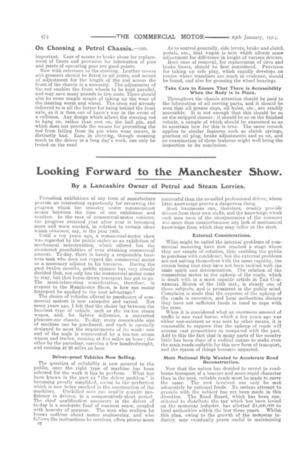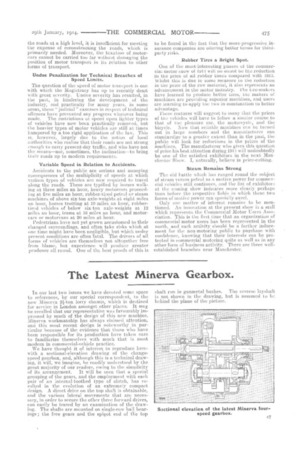Looking Forward to the Manchester Show.
Page 6

Page 7

If you've noticed an error in this article please click here to report it so we can fix it.
By a Lancashire Owner of Petrol and Steam Lorries.
Periodical exhibitions of any form of manufacture provide an interesting opportunity for reviewing the prop-,re&s which the industry under consideration makes between the time oi one exhibition , and another. In the case of commercial-motor vehicles, the progress attained year after year is becoming more and more marked, in relation to certain ideas which obtained, say, in the year 1905. Until a few years ago, a commercial-motor show was regarded by the public rather as an exhibition of mechanical monstrosities, which offered , but thO slenderest possibilities of ever 'attaining commercial success. To-day, there is hardly a responsible business man who does not regard the commercial motor as a necessary adjunct to his business. During the past twelve months, public opinion has very clearly decided that, not only has the commercial motor come to stay, but that horse-drawn transport has got to go. The most-interesting consideration, therefore, in respect to the Manchester Show, is how can motor transport be applied to the best advantage ? The choice of vehicles offered to purchasers of commercial motors is now extensive and varied. Not many years ago, I felt that the choice lay between the heaviest type of vehicle, such as the six-ton steam wagon, and„ for lighter deliveries, a converted pleasure-car chassis. To-day, every conceivable size of machine can be purchased, and each is specially designed to meet the requirements of its work : one end of the scale is represented by a ten-ton steam wagon and trailer, running at five miles an hour the other by the parcelcar, carrying a few hundredweight, and running at 20 miles an hour.
Driver-proof Vehicles Now Selling.
The question of reliability is now assured to the public, once the right type of machine has been selected for the work it has to perform. What has been known in the past as " the driver problem" is becoming greatly simplified, owing to the, perfection which is now being reached in the construction of the machines. Unskilled men can readily acquire proficiency in driving, in a comparatively-short period. The chief qualification necessary in the driver of to-day is a moderate fund of common sense, coupled with honesty of purpose. The man who realizes he knows nothing about motor engineering, and who foflows the instructions he receives, eften proven MOTO
successful than the so-called professional driver, whose little knowledge proves a dangerous thing.
Most businesses can, therefore, readily provide drivers.from their own staffs, and the knowledge which such men have of the idiosyncrasies of the business wit' more than counterbalance any lack of mechanical knowledge from which theyntay suffer at the start.
External Considerations.
Inat might be called the internal problems of commercial motoring have now reached a stage where they are simple of solution, thus enabling the public to purchase with confidence, but the external problems are not solving themselves with the same rapidity, the reason being that they have not been tackled with the same spirit and determination. The relation of the commercial motor to the upkeep of the roads, which is dealt with in a most capable article in THE COMMERCIAL MOTOR of the 15th inst., is clearly one of those subjects, and is prominent in the public mind. Complaint in made that the expense of the upkeep of the roads is excessive, and local authorities declare they have not sufficient funds in hand to cope. with the same.
When it is considered what an enormous amount of traffic is now road borne, which a few years ago was either non-existent or was sent by other means, it is reastmable to suppose that the upkeep of roads will assume vast proportions as compared with the past. Add to this the fact that in many parts of the country little has been done of a radical nature to make even the main roads suitable for this new form of transport, and the reason of things becomes apparent.
More National Help Wanted to Accelerate Road Reconstruction.
Now that the nation has decided to revert to roadborne transport of a heavier and more-rapid character than in the past, suitable roads must be made to carry the same. The cost involved can only be met adequately by national funds. No serious attempt to grannie with the subject has yet been made in this direction. The Road Board, which has been constituted to distribute the tax which has been levied on the motorcar industry, has allotted 24,500,000 to local authorities within the last three years. Whilst this plan, owing to the growth of the motorcar industry, may eventually prove useful in maintaining
the roads at a high level, it is insufficient for meeting the expense of reconstructing the • roads, which is primarily needed. Moreover, the taxation of motorcars cannot be carried too far without damaging the position of motor transport in its relation to other torms of transport.
Undue Penalization for Technical Breaches of Speed Limits.
The question of the speed of motor transport is one with which the Magistracy has up to recently dealt with great severity. Undue severity has resulted, in the past, in hindering the development of the industry, and practically for many years in some areas, these "judicial " excesses in respect of technical offences have prevented any progress whatever being made. The restrictions ot speed upon lighter types of vehicles have now been practically removed, but the heavier types of motor vehicles are still at times hampered by a too rigid application of the law. This is, however, largely due to the action of local authorities who realize that their roads are not strong enough to carry present-day traffic, and who have not the means—nor, sometimes, the inclination—to bring their roads up to modern requirements.
Variable Speed in Relation to Accidents.
Accidents to the public are serious and annoying consequences of the multiplicity of speeds at which various types of vehicles are now required to travel along the roads. These are typified by horses walking at three miles an hoar, heavy motorcars proceeding at five miles an hour, rubber-tired petrol or steam machines of above six-ton axle-weights at eight miles an hour, horses trotting at 10 miles an hour, rubbertired vehicles of below six-ton axle-weights at 12 miles an hour, trams at 16 miles an hour, and motorcars or motorvans at 20 milos at hour.
Pedestrians have not yet grown accustomed to their changed surroundings, and often take risks which at one time might have been negligible, but which under present conditions are often -fatal. The drivers of all forms of vehicles are themselves not altogether free from blame, but experience will produce greater prudence all round. One of the best proofs of this is
to be found in the fact that the more-progreesive insurance companies are ollering better terms tor thirdparty risks.
Rubber Tires a Bright Spot.
One of the most-interesting phases of the commercial-motor show of 1914 wilt no doubt be the reduction in the price of all rubber times compared with 1913. Whilst this is due in some measure to the reduction in the price of the raw material, it also represents an advancement in the motor industry. The tire-makers have learned to produce better tires, the makers of machines are providing superior machines, and users are learning to apply the two in combination to better advantage.
These features will suggest to many that the prices of the vehicles will have to follow a similar course to that of the pleasure car, the motorcycle' and the bicycle. Now that reliable machines can be turned out in large numbers and the manufacturer can standardize to a greater extent than in the past, the public will look for reductions in the prices of the machines. The manufacturer who gives this question of price his best attention during 1911 will undoubtedly be one of the satisfied exhibitors in the next Manchester Show. I, naturally, believe in price-cutting.
Steam Remains Strong The old battle whichhas ranged round the subject of steam versus petrol as a motive power for commercial vehicles still continues, and the list of exhibitors at the coming show indicates more clearly perhaps than before the respective fields in which these two forms of motive power can specially excel.
Only one matter of interest remains to be mentioned. An innovation at the present show i3 a stall which represents the Commercial Motor Users Association. This is the first time that an organization of commercial-motor users has been represented in the north, and such activity should he a further inducement for the non-motoring public to purchase with confidence, knowing that their interests earl be protected in commercial motoring quite as well as in any other form of business activity. There are three wellestablished branches near Manchester.






































